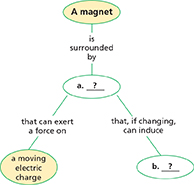CHAPTER 21 Study Guide
21.1 Magnets and Magnetic Fields
 Key Concepts
Key Concepts
Like magnetic poles repel one another, and opposite magnetic poles attract one another.
A magnetic field, which is strongest near a magnet's poles, will either attract or repel another magnet that enters the field.
When a material is magnetized, most of its magnetic domains are aligned.
Vocabulary
magnetic force, p. 630
magnetic pole, p. 630
magnetic field, p. 631
magnetosphere, p. 632
magnetic domain, p. 632
ferromagnetic material, p. 632
21.2 Electromagnetism
 Key Concepts
Key Concepts
Moving electric charges create a magnetic field.
Changing the current in an electromagnet controls the strength and direction of its magnetic field.
Electromagnetic devices such as galvanometers, electric motors, and loudspeakers change electrical energy into mechanical energy.
Vocabulary
electromagnetic force, p. 635
solenoid, p. 637
electromagnet, p. 637
galvanometer, p. 638
electric motor, p. 639
21.3 Electrical Energy Generation and Transmission
 Key Concepts
Key Concepts
According to Faraday's law, a voltage is induced in a conductor by a changing magnetic field.
The two types of generators are AC generators and DC generators.
A transformer changes voltage and current by inducing a changing magnetic field in one coil. This changing field then induces an alternating current in a nearby coil with a different number of turns.
Most of the electrical energy generated in the United States is produced using coal as an energy source. Some other sources are water (hydroelectric), nuclear energy, wind, natural gas, and petroleum.
Vocabulary
Thinking Visually
Concept Map Copy the concept map below onto a sheet of paper. Use information from the chapter to complete the chart.





